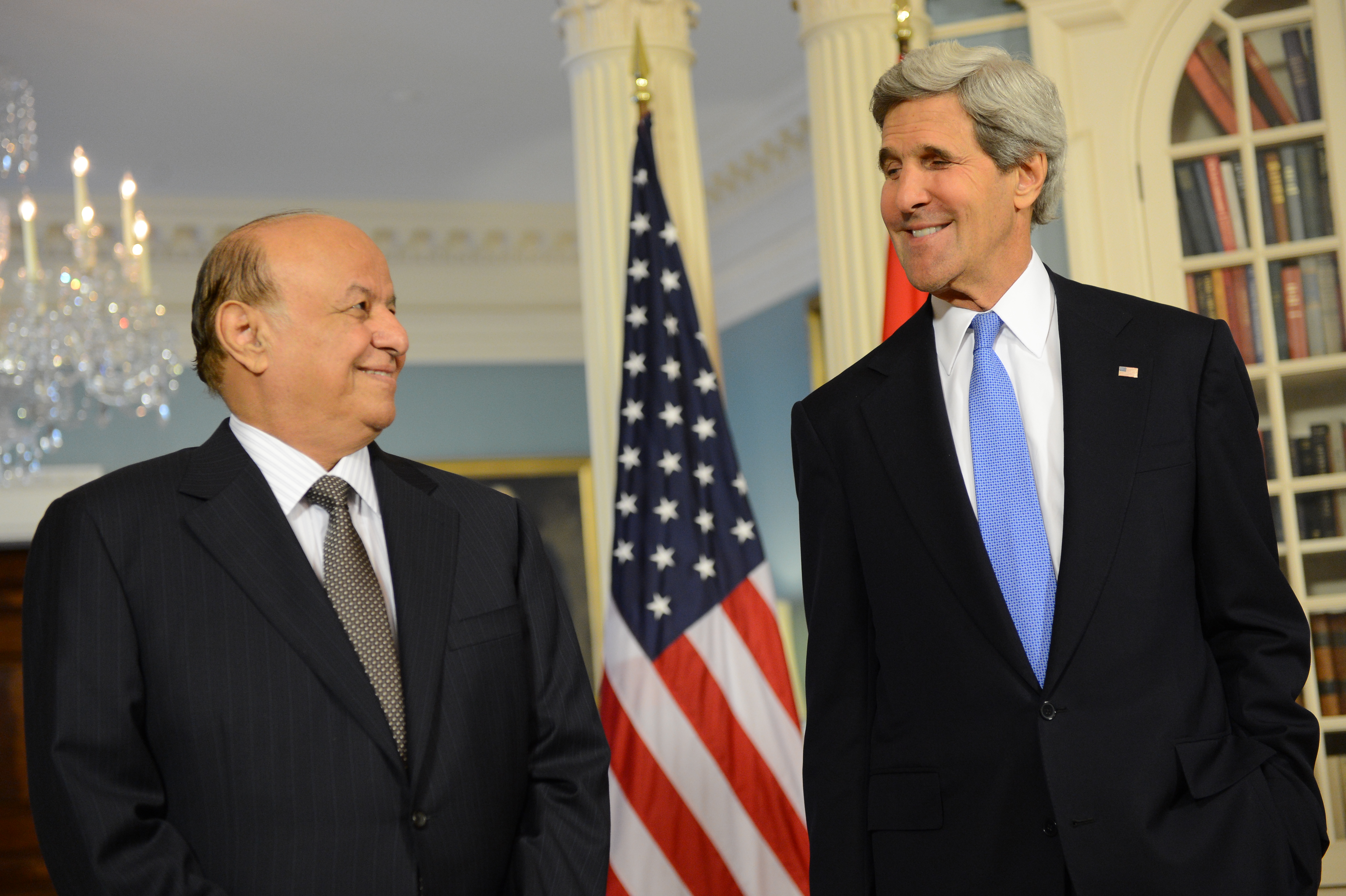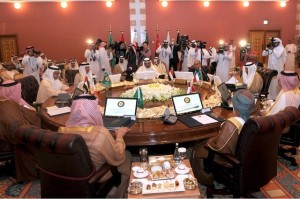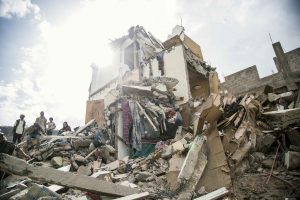by Sheila Carapico
Four years after the popular uprising against the dictatorship of ‘Ali ‘Abdallah Salih, the weak Saudi-backed transitional government of Abed Rabbo Mansour Hadi collapsed, leaving Sana’a to Iranian allies. As of this writing, we don’t even know where Yemen’s capital is.
In 2011, a mass uprising/campout across Yemen outlasted any of the other Arab springs. It was mostly peaceful, although the authorities killed 50-plus demonstrators one day in March of that year and President Salih himself was seriously injured in an assassination attempt that May.
While Salih was recuperating in Saudi Arabia, leaders of a national dialogue that had tried to negotiate the impasse between northern and southern leaders in 1994 re-launched that effort. This project was overtaken by the Gulf Cooperation Council (GCC) deal whereby Salih handed presidential power to his hand-picked vice president in exchange for immunity. Salih remained the head of the ruling party, which in turn retained its parliamentary majority. This deal was signed in Saudi Arabia, with witnesses from the Gulf monarchies but not Yemen’s so-called “revolutionary youth.” Also under the GCC initiative, Hadi was “elected” president in a one-candidate vote, and international donors invested heavily in a 656-person National Dialogue Conference overseen by UN special envoy Jamal Ben Omar.
Hadi Out, Houthi In
In February President Hadi, whose two-year term had already technically expired, resigned under pressure from a rag-tag rebel group called the Houthis, or Ansar Allah. They had swept from their base near the Saudi border in September without encountering much resistance except in ‘Amran, a province north of Sana’a. With Hadi’s surrender the US, other NATO powers, and neighboring Arab Gulf monarchies (collectively known as the Group of 10, the Gang of 10, or the Friends of Yemen) closed their embassies in Sana’a, evacuated their diplomats, and urged citizens to flee the country.
Responding to appeals from Secretary-General Ban Ki-Moon and the Obama administration, the UN Security Council unanimously voted for resolution 2201. The toothless resolution and press statement told the Houthi rebels to surrender their recent military gains and asked everyone to get behind the GCC initiative, the draft constitution, and President Hadi.
Almost simultaneously, the UN issued a scathing report that Salih had siphoned over $60 billion from public coffers during his three-decade kleptocracy. It was also widely alleged that Salih, who previously prosecuted six wars against the Houthis, facilitated their advance against the government of his former vice president. Either or both of these estimates may be exaggerated, though there is no doubt that Salih was enormously corrupt and an expert spoiler-gamesman.
On February 21, Hadi evidently escaped house arrest and fled Sana’a for Aden, the capital of the former People’s Democratic Republic of (South) Yemen (the old PDRY that unified with North Yemen in 1990 and tried to divorce four years later only to suffer military defeat). As he is a native southerner and former Socialist—even though in the meantime he had joined the Sana’a-based Salih government—Hadi considers Aden more or less his home turf. From there, in an uncharacteristically bold move, he rescinded his resignation and announced the reestablishment of his ousted government in the new, now interim Yemeni capital of Aden.
GCC and American Reactions
The GCC monarchies, panicked over Iranian support for the Houthi takeover, hastened to relocate embassy functions to Aden (one wonders how they rented office space so quickly). On February 25, GCC Secretary-General Abdullatif al-Zayani, of Saudi Arabia, visited Hadi in Aden in an affirmation of his “legitimate” government, according to the Khaleej Times.
The newly appointed US Ambassador to Yemen, Matthew Tueller, also flew to Aden to meet with Hadi and reaffirm continuing American endorsement of the GCC initiative. As Secretary of State John Kerry prepared to meet with foreign ministers of the GCC, Tueller announced that he will work out of a U.S. consulate in Jeddah, Saudi Arabia. There is nothing new in this: officials of the Bush and Obama administrations customarily conducted diplomacy over Yemen through the Kingdom.
The media commentary on these events provided some context, especially in terms of the long-standing dominant Saudi role in Yemen’s domestic affairs, but ventured few reliable predictions apart from a sense of impending doom. Helen Lackner’s reflections on the viewpoints of Gulf and Western donors recognize the complicated political background, including the anxieties of the Kingdom of Saudi Arabia and other Gulf monarchs over genuine democratization, Iranian-backed Houthis, and/ or al-Qaeda in the Arabian Peninsula’s ability to take advantage of the power vacuum. Nafeez Ahmed has pointed to the confluence of crises surrounding oil, water, and the counter-terror policies of purported benefactors. I argued recently that the GCC-UN initiative, designed to deflect popular aspirations in favor of Saudi hegemony, ultimately produced an ill-conceived constitutional blueprint that had already buckled under the inertia of endless transition.
Iranian Inroads
On February 26, Ansar Allah leader Abd al-Malik al-Houthi delivered a fiery but mostly plausible speech about Saudi, GCC, and US interference in Yemen’s internal politics. He is a better speaker than the taciturn Hadi or the impromptu al-Zayani. Al-Houthi’s diatribes about the ways in which GCC policies perpetuate Yemeni poverty and unrest would resonate among Yemenis and Yemen-watchers wary of Yemen’s position as the subaltern labor reserve to the super-wealthy Gulf and angry about American drone attacks that continue as if nothing else was happening.
Yet Saudi and American fears of Iranian influence cannot be discounted. Houthi’s remarks were broadcast in simultaneous translation on Iran’s Press TV. Concurrently Houthi authorities in Sana’a signed an aviation deal with Tehran for 14 weekly flights between the two capitals, starting with an Iranian plane loaded with medical supplies sent by the Iranian Red Crescent.
For the moment, there seems to be an Iranian-backed Houthi government in Sana’a and a US-Saudi-backed government in Aden. Domestically, they each seem to have more opponents than supporters. All this is counterintuitive in terms of the status quo ante or even developments in late 2014. It is unclear how factions in the Southern Hirak will respond to a redefinition of Yemeni “unity,” what ‘Ali ‘Abdallah Salih’s next move will be, how various tribal forces will play their cards, which Gulf princes and millionaires will buy off what Yemeni parties, and whether Washington will grapple with Yemeni politics as anything beyond Saudi hegemony or the global war on terror.
Sheila Carapico is Professor of Political Science and International Studies at the University of Richmond. Carapico is the author of Civil Society in Yemen: The Political Economy of Activism in Modern Arabia (Cambridge University Press, 1998) and numerous articles and book chapters on Yemen, the Arabian Peninsula, and the region. A contributing editor to Middle East Report, she has also written essays for several publications about the Egyptian and Yemeni revolutions of 2011. Her most recent book is Political Aid and Arab Activism: Democracy Promotion, Justice and Representation (Cambridge University Press, 2013).
Photo: Abed Rabbo Mansour Hadi with John Kerry






Perhaps if the U.S. didn’t believe it was its divine right to be everywhere, calling the shots to keep turmoil going, or better said, out of the M.E., we wouldn’t be having this conversation.